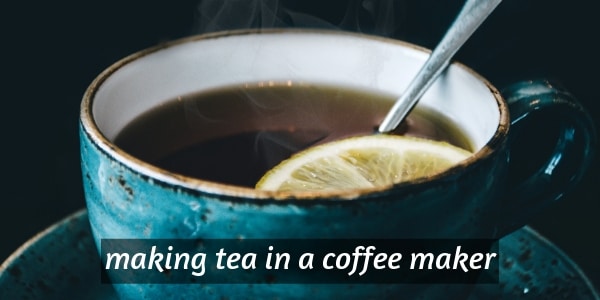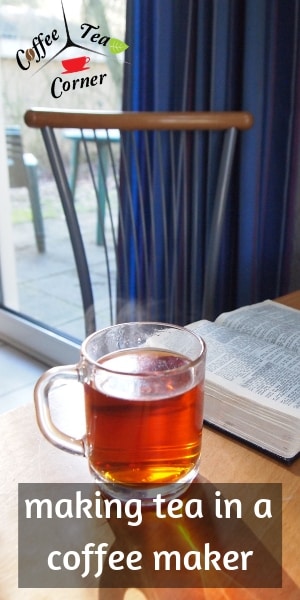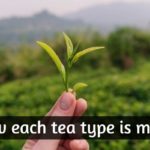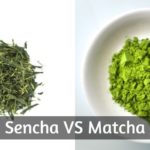If you're planning on making tea with your coffee maker, let's first see if that idea holds up. And which coffee maker would be alright for making coffee as well.
Not all coffee makes are the same, and you might be surprised to find out your favorite coffee brewing method fails at making good tea.
Let's avoid that scenario and see which would be the best. But first let's see if this could work.
Table of Contents
So can you make tea with a coffee maker ?
Yes, you can make tea with a coffee maker. You can brew tea with a coffee maker if you can easily adjust the water's temperature, and steeping time. This means the French press and Turkish ibric are good for making tea, you are in control of every variable.
Not all coffee machines are the same, and not all coffee brewing methods lend themselves to tea making.
Automated coffee machines won't work well, as you can scald the tea and get a bitter taste.
The kind of tea you use is going to be the main judge here. Herbal teas can take a very hot water, while green tea is ruined by overly hot water.
But let's delve into this more deeply, ans see which would work best. Starting with the beloved espresso.
1. Espresso machine is a no for tea, unless you have tea pods
The problem with espresso is that you're not in control, at all. If you're using loose leaf teas, like a white or a green, you're going to burn your tea.
The water in an espresso machine is usually over 90 C/194 F. That is much too hot for a green tea, which needs a maximum of 80 C/176 F, or else it becomes very bitter and unpleasant. It can even turn a darker color.
If you're using white tea, the problem is the same. Even greater, actually, since white tea is much more delicate and floral than green tea. Scalding white tea results in a very poor tea extraction as well.
Black tea could maybe handle the high temperature of the water. It's meant to be brewed at 90 C/194 F so it might handle something higher, but you'd have to fiddle with the water a lot.
Herbal teas, these could withstand the high temperature, if you were to place them in the filter basket. However they too risk being scalded, especially the flowery ones.
The same goes for Rooibos tea, which is brewed like black tea.
Basically no tea can handle temperatures of 90-96 C/194-204 F.
Temperature aside, there is also the matter of the brewing time. An espresso is done in under a minute. That's the main point of an espresso, it's a quick and strong shot of coffee.
Tea on the other hand doesn't work like that. Tea is very sensitive, and requires several minutes of steeping. Green tea needs about 2-3 minutes, black needs around 3-5 minutes, the white tea needs a bit longer than that.
Herbal and rooibos teas are done after 5 minutes but you can leave them for 10 if you want and they'll be fine.
This can't and does not happen in an espresso machine, because of the way the machine is built.
There are however tea pods, which are a sort of compromise. Up until now I've been talking about loose leaf teas. Those provide the best flavor, and are the way tea is meant to be extracted.
But for the sake of convenience, tea pods have been invented. They do come at a loss, though. Much like with instant coffee, they cannot provide the true flavor of the tea you're meant to be drinking.
As such,they're often masked with different enhancing flavors, and adding sugar to them will further hide that.
That being said, tea pods are available only for espresso machines that have the compartment. They're quick, hot, and ready to be enjoyed as soon as you pick up your cup.
2. Moka pot/percolator will scald the tea
A Moka pot is a type of brewing vessel that's nearly a century old. It's usually a stovetop coffee maker, though it can be found as an electric version nowadays.
The reason a Moka pot, also called a percolator, wouldn't work with tea is because of the very principle that makes it work.
You see, the Moka pot is made of 3 chambers. The lowest chamber you will with water. On top of that you add the middle chamber, much smaller, which is where you would put the tea leaves or bags.
On top of that you would get the upper chamber, which is empty and is where the tea would collect once it's brewed.
Once you put the Moka pot over heat, the lower chamber will heat up. The water will steam and start to boil, the pressure will make it rise through the filter where the tea is and up into the upper chamber.
There is a spigot connecting all 3 chambers for the liquid to get where it needs to.
But this only happens with water that's near-boiling, like with espresso machines.
Actually, the Moka is a sort of precursor to the espresso machine itself. More on that later, though.
So as with the espresso machine, the Moka pot would scald the tea. Brewing time would not be a problem, since this takes more time than an espresso.
However it's always at too high a temperature for any tea to be made. No tea ever needs to be made at nearly 100 C/212 F.
3. Turkish ibric is very close to how tea is meant to be made
Ah, the Turkish ibric. My college sweetheart, I could say. I've had the one small pot, in which I've made coffee for years. And in that same pot I've made tea as well.
I can confidently assure you that an ibric will let you brew tea just the way you like it. This is because the ibric is just a very small and delicate pot.
So you can boil your water in the ibric, take it off the heat and let it sit for a minute. Add you tea leaves, or herbal tea, or whatever kind of tea you like, and you're done.
You are in control of how hot the water is when you add the tea leaves.
You also control how long to leave the tea to steep, and there are far less bitter and burned teas going on with such a method.
This works beautifully with any tea type, be it actual tea from the tea plant, or a herbal tea.
Tell me this isn't very close to the way most people make their teas. Along with straining the tea into a cup, and then possibly reusing the tea leaves after a few minutes.
Of course, you'd be using a much larger water pot and making larger tea batches. But the principle is the same.
The only drawback is the cleanup, if you're just leaving your leaves in the water. In a way, this is the best method as it allows them room to expand as much as they need to and give their full flavor.
However putting them in a tea ball, or empty tea bag makes things much, much easier.
If you decide to make your tea in the Turkish ibric, make sure to not add sugar or anything else to the tea until you've strained or poured it into your cup.
Adding anything else to the brewing process will disturb it.
(If you like this article so far, you can pin it to your Pinterest board by clicking the image below. The article continues after the image.)
4. Drip filter is very iffy with tea
A drip filter, or simply filter, is a machine that's possibly the most common for coffee making across the world. The espresso is sometimes preferred, yes, but the filter coffee is the one most well known.
Now, if you were to switch your coffee for tea there would be a few problems.
Of course, you can add your tea leaves to the filter basket. Many filters, if not all nowadays, have an anti-drip system. If you don't place the coffee pot under the nub, it won't drip. It does have a maximum point, though.
So in a way you can control the amount of steeping time for your tea, if you only make one cup. More than one cup will possibly make the filter basket overflow if you don't let the nub drip.
But let's say you only make the one cup, and everything goes well and nothing is overflowing.
You'll be met with possibly bitter and burnt tea. This is because the water used in a filter is a very hot one, actually about as hot as an espresso.
So again, your tea would be scalded and you wouldn't really be able to make any tea very well.
You could try using some black tea, or rooibos, or herbal, and not letting the nub drip. Again, only for one cup or else the filter might spill over.
The resulting tea could be possibly scalded, but it could be saved with a bit of sugar, or natural sweeteners.
But what if you added your tea to the coffee pot and let how water drip over it ? You'd get pretty much the same result, seeing as the water is the same temperature.
You'd have an easier time controlling the steeping time, though.
I guess you could get around the temperature problem by adding cold water to the coffee pot, before you turn on the filter.
So when the hot water from the filter drips into the coffee pot, it would meet the cold water and create a temperature that's okay for the tea you're using.
That could work, and you could leave it for as long as needed to steep.
However I think those are some extra steps that aren't really necessary. At this point it's best to just boil some water and make regular tea. But if the coffee filter is all you've got, the go ahead and add the cold water to the coffee pot.
Not much, just a bit to lower the temperature from nearly 100 c/212 F to about 80 C/176 F. It's important that you do this before the hot water ever touches the tea, loose leaf or not.
5. French press seems to be the best method for tea
The best method seems to be the French press. I think it's even better than the Turkish ibric, simply because of how easy it is to separate the leaves from the brew.
Almost like a teapot, you could say.
The way the French press works is that you add your tea leaves or tea bags, and add the hot water. Again, here you are in control of the water temperature and can adjust it to whatever you like.
Then you add the plunger, and attach the lid. Now all you have to do is wait for the tea to brew, which can take anywhere from 2 minutes to 7, depending on what kind of tea you're using.
When you've decided your tea is done brewing, then you're only left with pushing the plunger down. Do not rush it, since you might encounter quite a bit of resistance in the vessel.
French press for tea making is something I've seen quite often, and it's certainly something, otherwise people wouldn't be using it still.
The fact that it's so easy to separate the drink from the refuse is something that might seem small at first, but it's actually very convenient. Yes, you need to wash it afterwards like any other tea making pot, but still.
Conclusion for the best coffee maker to make tea in
In the end, I think it's up to each person to decide which method they like best. Some simply won't work, some will work very well if you tweak them a bit.
For me the Turkish ibric was the best method, and still is. I do use a larger pot, which can hold 2-3 cups of tea but it's the way I've made tea ever since I started making tea.
Of course, the runner up is the French press. Simple, no mess, and very easy to clean up.
And in a pinch, the filter would do just fine. If you added a bit of cold water to the coffee pot before you started the machine, that is.
The kind of tea you mean to use matters
Let's go back a bit to the kind of tea you're using. I mentioned it briefly, but ti needs a bit more understanding.
Not all teas are the same. This means some can stand up to hot water better than most, and some don't need a very long steeping time either.
If you're planning on using teabags, then you can use the filter even without the cold water added beforehand. This is because teabags are usually very flavorful, actually more than they need to be, in order to give you everything they've got.
They also brew very very quickly, in 2-3 minutes actually. So there's not much fuss with them.
Now aside from this you need to know if you're using herbal tea or tea leaves.
Herbal teas need a bit longer to brew, even in their loose form. But they're still temperature sensitive, so scalding them won't work very well. However if any tea will be still drinkable if it were scalded, then the herbal teas would be winners.
So if you're using teabags with herbal tea, you can pretty much use any coffee machine aside from an espresso or Moka.
But if you're using tea leaves, then remember that those are very delicate and need to be watched. Even if you use a green tea teabag, it would still turn bitter if you scald it or leave it for too long.
It would brew in about a minute, since small broken leaves brew much faster than whole leaves. They give less rounded flavors, though.
So it's up to you, and what kind of tea you're going to use in your tea brew.
Final thoughts
I hope I helped you out in choosing a coffee maker to make tea with. Some of them can be used as they were meant and still produce very good tea, some are not exactly the best.
For example for filter coffee, if you've been using the reusable filter that came with your machine, you would still get a faint coffee taste. Even after you wash it very well and rinse it into oblivion, the taste is still there.
If you want to know more about coffee or tea, feel free to check the related articles below. Who knows what else you might find ?






